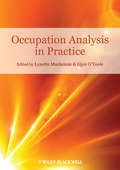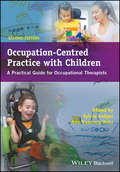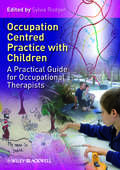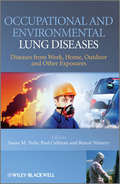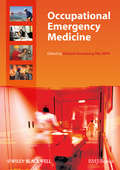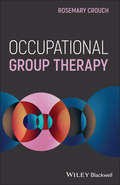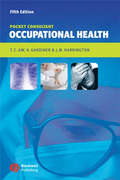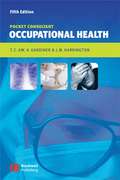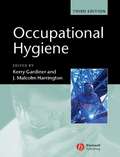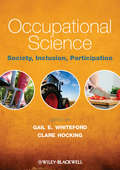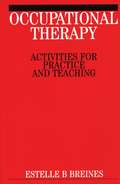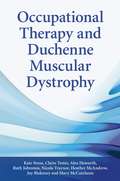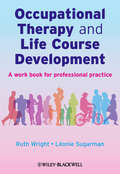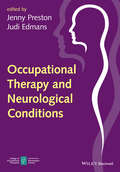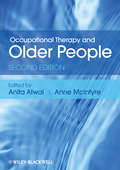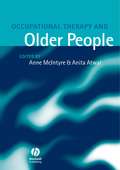- Table View
- List View
Occupation Analysis in Practice
by Lynette Mackenzie Gjyn O’TooleOccupation Analysis in Practice is the essential book for all future and current occupational therapists. It offers a practical approach to the analysis of occupations in real world practice. The book frames occupation as the key component for analysis and builds upon previous work limited to analysis at the activity level. It examines the interests, goals, abilities and contexts of individuals, groups, institutions and communities, along with the demands of the occupation. It presents examples of occupation analysis in different practice context including working with children, health promotion, indigenous health, medico-legal practice; mental health and occupational rehabilitation. The book has four sections. Section 1 introduces theoretical perspectives of the concept of occupation analysis and how such analysis relates to particular models of Occupational Therapy practice and the generic World Health Organisation International Classification of Functioning, Disability and Health. Section 2 discusses analysis of particular components of occupation that support practice. These include culture, spirituality, home and community environments as well as self-care and leisure. Section 3 applies analysis of occupations to particular specialties encountered in practice. Section 4 considers the application of Occupation Analysis within professional reasoning and goal setting. FEATURES International team of contributors Examples of occupation analysis proforma Application to a wide range of practice areas. Glossary of key terms Incudes the International Classification of Functioning, Disability and Health.
Occupation Analysis in Practice
by Lynette Mackenzie Gjyn O'TooleOccupation Analysis in Practice is the essential book for all future and current occupational therapists. It offers a practical approach to the analysis of occupations in real world practice. The book frames occupation as the key component for analysis and builds upon previous work limited to analysis at the activity level. It examines the interests, goals, abilities and contexts of individuals, groups, institutions and communities, along with the demands of the occupation. It presents examples of occupation analysis in different practice context including working with children, health promotion, indigenous health, medico-legal practice; mental health and occupational rehabilitation. The book has four sections. Section 1 introduces theoretical perspectives of the concept of occupation analysis and how such analysis relates to particular models of Occupational Therapy practice and the generic World Health Organisation International Classification of Functioning, Disability and Health. Section 2 discusses analysis of particular components of occupation that support practice. These include culture, spirituality, home and community environments as well as self-care and leisure. Section 3 applies analysis of occupations to particular specialties encountered in practice. Section 4 considers the application of Occupation Analysis within professional reasoning and goal setting. FEATURES International team of contributors Examples of occupation analysis proforma Application to a wide range of practice areas. Glossary of key terms Incudes the International Classification of Functioning, Disability and Health.
Occupation-Centred Practice with Children: A Practical Guide for Occupational Therapists
by Professor Sylvia Rodger Ann Kennedy 8208 BehrOccupation-Centred Practice with Children remains the only occupational therapy book which supports the development and implementation of occupation-centred practice with children. Drawing on the latest occupational therapy theory and research, this new edition has been fully updated throughout, and includes new chapters on occupational transitions for children and young people, assessing children’s occupations and participation, intervention within schools, the arts and children’s occupational opportunities, as well as using animals to support children’s occupational engagement. Key features: Written by an international expert team of contributors. Each chapter begins with preliminary questions to assist with consideration of current knowledge, and then reflection questions at the conclusion to allow revision of key content in order to support independent learning. Highly practical, with a range of case studies, key point summaries, reflective questions, best practice guidelines, and a range of tools, interventions and techniques to aid applications to practice. A new appendix outlining all the assessments referred to in the book has now been included. Occupation-Centred Practice with Children is a practical, theoretically grounded and evidence based guide to contemporary occupational therapy practice, and is important reading for all occupational therapy students and therapists wishing to make a real difference to children and their families’ lives.
Occupation Centred Practice with Children: A Practical Guide for Occupational Therapists
by Sylvia RodgerThis book draws on contemporary occupational therapy theory and research to provide occupational therapy students and clinicians with a practical resource on implementing occupation centred practice with children. Each chapter has specific objectives and uses case studies to demonstrate the clinical realities and applications of each of the topics addressed. Best practice guidelines are provided along with a summary of recommendations drawn from the relevant theories, occupational therapy philosophy and existing research. The book aims specifically to be practice based.
Occupation-Centred Practice with Children: A Practical Guide for Occupational Therapists
by Sylvia Rodger Ann Kennedy-BehrOccupation-Centred Practice with Children remains the only occupational therapy book which supports the development and implementation of occupation-centred practice with children. Drawing on the latest occupational therapy theory and research, this new edition has been fully updated throughout, and includes new chapters on occupational transitions for children and young people, assessing children’s occupations and participation, intervention within schools, the arts and children’s occupational opportunities, as well as using animals to support children’s occupational engagement. Key features: Written by an international expert team of contributors. Each chapter begins with preliminary questions to assist with consideration of current knowledge, and then reflection questions at the conclusion to allow revision of key content in order to support independent learning. Highly practical, with a range of case studies, key point summaries, reflective questions, best practice guidelines, and a range of tools, interventions and techniques to aid applications to practice. A new appendix outlining all the assessments referred to in the book has now been included. Occupation-Centred Practice with Children is a practical, theoretically grounded and evidence based guide to contemporary occupational therapy practice, and is important reading for all occupational therapy students and therapists wishing to make a real difference to children and their families’ lives.
Occupational and Environmental Lung Diseases: Diseases from Work, Home, Outdoor and Other Exposures
by Susan M. Tarlo et al.Documents both environmental and work-related causes of lung disease Unlike other books on the subject, this new volume approaches occupational and environmental lung disease from the starting point of the patient who comes to the physician with respiratory symptoms. The authors recognize that potentially harmful exposures occur not only in the work environment, but also as a result of hobbies or other leisure activities, or from outdoor air pollution, and it is up the physician to identify whether a particular job or hobby is the cause of the patient’s respiratory symptoms. To help you arrive at a differential diagnosis, chapters in the book are arranged by job or exposure, and are divided into 5 sections: Personal environment Home environment Other indoor environments Work environment General environment Each is written by an expert in the specific topic and provides pragmatic information for the practicing physician. This practical book is an invaluable resource that belongs close at hand for all physicians dealing with patients experiencing respiratory symptoms.
Occupational and Environmental Lung Diseases: Diseases from Work, Home, Outdoor and Other Exposures
by Susan Tarlo Paul Cullinan Benoit NemeryDocuments both environmental and work-related causes of lung disease Unlike other books on the subject, this new volume approaches occupational and environmental lung disease from the starting point of the patient who comes to the physician with respiratory symptoms. The authors recognize that potentially harmful exposures occur not only in the work environment, but also as a result of hobbies or other leisure activities, or from outdoor air pollution, and it is up the physician to identify whether a particular job or hobby is the cause of the patient’s respiratory symptoms. To help you arrive at a differential diagnosis, chapters in the book are arranged by job or exposure, and are divided into 5 sections: Personal environment Home environment Other indoor environments Work environment General environment Each is written by an expert in the specific topic and provides pragmatic information for the practicing physician. This practical book is an invaluable resource that belongs close at hand for all physicians dealing with patients experiencing respiratory symptoms.
Occupational Emergency Medicine
by Michael GreenbergWith a large proportion of emergency admissions due to occupational health problems, the effect this can have on your practice cannot be ignored. Owing to the shortage of occupational physicians and limited worker access to health care, the diagnosis and treatment of occupational diseases rely increasingly on the emergency physician. Apart from extra paperwork, owing to the extra legal and administrative regulations, a lack of knowledge of occupational medicine can risk a missed diagnosis. This burden of work means occupational disorders impact the whole of the emergency department. Michael Greenberg addresses your questions and concerns about the management of these patients: from triage to discharge, and beyond for all work-place injuries or disorders, whether office-based, agricultural or industrial and their employment regulations Occupational Emergency Medicine is an essential reference for emergency physicians and trainees, featuring comprehensive information on legal issues involving the physician, and advice on managing occupational health admissions.
Occupational Emergency Medicine
by Michael GreenbergWith a large proportion of emergency admissions due to occupational health problems, the effect this can have on your practice cannot be ignored. Owing to the shortage of occupational physicians and limited worker access to health care, the diagnosis and treatment of occupational diseases rely increasingly on the emergency physician. Apart from extra paperwork, owing to the extra legal and administrative regulations, a lack of knowledge of occupational medicine can risk a missed diagnosis. This burden of work means occupational disorders impact the whole of the emergency department. Michael Greenberg addresses your questions and concerns about the management of these patients: from triage to discharge, and beyond for all work-place injuries or disorders, whether office-based, agricultural or industrial and their employment regulations Occupational Emergency Medicine is an essential reference for emergency physicians and trainees, featuring comprehensive information on legal issues involving the physician, and advice on managing occupational health admissions.
Occupational Group Therapy
by Rosemary CrouchOccupational Group Therapy helps group leaders achieve a higher and more dynamic level of therapeutic intervention, gain a better understanding of foundational concepts and research, and utilise active techniques that have meaningful and lasting effects on their clients. This practical guide encourages readers to use and develop their skills creatively in a range of interventions, including hospital-based work with acutely ill clients, physical acute care, and rehabilitation. The text presents both the theoretical background and practical applications of occupational group therapy: core skills and concepts, styles of group leadership, clinical and ethical reasoning, and different models of therapy such as the functional group model, the model of human occupation (MOHO), and the occupational therapy interactive group model (OTIGM), alongside warm-up and ice-breaker techniques, role-play exercises, assertiveness and social skills training strategies, guidance on using psychodrama and the therapeutic spiral model (TSM) in group settings, and more. Develops the skills and self-confidence occupational therapists need to be effective group leaders Covers the functional and performance aspects necessary for occupational therapy intervention, including client handling, and structuring and communication skills. Discusses new ways of addressing common concerns and issues in various intervention settings Offers ideas and techniques for using higher-level interventions, such as psychodrama and the Therapeutic Spiral model Helps readers to design effective group experiences that allow their clients to “work on themselves” both inside and outside of the group Written by an esteemed expert with decades of practical experience in the field, with a chapter from Louise Fouché, an accomplished occupational group therapist and developer of OTIGM, and foreword by Professor Emerita Sharon Brintnell, former President of World Federation of Occupational Therapy (WFOT): Occupational Group Therapy is a must-have teaching manual and guide for undergraduate and post-graduate occupational therapy students, and for practitioners looking to increase their use of group work as a therapeutic intervention.
Occupational Group Therapy
by Rosemary CrouchOccupational Group Therapy helps group leaders achieve a higher and more dynamic level of therapeutic intervention, gain a better understanding of foundational concepts and research, and utilise active techniques that have meaningful and lasting effects on their clients. This practical guide encourages readers to use and develop their skills creatively in a range of interventions, including hospital-based work with acutely ill clients, physical acute care, and rehabilitation. The text presents both the theoretical background and practical applications of occupational group therapy: core skills and concepts, styles of group leadership, clinical and ethical reasoning, and different models of therapy such as the functional group model, the model of human occupation (MOHO), and the occupational therapy interactive group model (OTIGM), alongside warm-up and ice-breaker techniques, role-play exercises, assertiveness and social skills training strategies, guidance on using psychodrama and the therapeutic spiral model (TSM) in group settings, and more. Develops the skills and self-confidence occupational therapists need to be effective group leaders Covers the functional and performance aspects necessary for occupational therapy intervention, including client handling, and structuring and communication skills Discusses new ways of addressing common concerns and issues in various intervention settings Offers ideas and techniques for using higher-level interventions, such as psychodrama and the Therapeutic Spiral model Helps readers to design effective group experiences that allow their clients to “work on themselves” both inside and outside of the group Written by an esteemed expert with decades of practical experience in the field, with a chapter from Louise Fouché, an accomplished occupational group therapist and developer of OTIGM, and foreword by Professor Emerita Sharon Brintnell, former President of World Federation of Occupational Therapy (WFOT): Occupational Group Therapy is a must-have teaching manual and guide for undergraduate and post-graduate occupational therapy students, and for practitioners looking to increase their use of group work as a therapeutic intervention.
Occupational Health: Pocket Consultant (Pocket Consultant #4)
by Tar-Ching Aw Kerry Gardiner J. M. HarringtonOffering a balance of theory and practice, with guides for further reading, this is a clinical guide for the practitioner in the widest sense: physicians, nurses, occupational hygienists, safety officers, environmental, health officers and personnel managers. With coverage of both medicine and hygiene, and including sections on OH law, it is a primer for appropriate courses and provides all that the interested medical student would need to know.
Occupational Health: Pocket Consultant (Pocket Consultant #4)
by Tar-Ching Aw Kerry Gardiner J. M. HarringtonOffering a balance of theory and practice, with guides for further reading, this is a clinical guide for the practitioner in the widest sense: physicians, nurses, occupational hygienists, safety officers, environmental, health officers and personnel managers. With coverage of both medicine and hygiene, and including sections on OH law, it is a primer for appropriate courses and provides all that the interested medical student would need to know.
Occupational Hygiene
by Kerry Gardiner J. Malcolm HarringtonEmployees, employers and the government have all become very aware of the effects on health of the work environment. As a result, this subject area is rapidly developing with recent changes in legislation, sampling and measurement methods, as well as a new emphasis on the psychological impact of work, and the importance of an appropriate work-life balance. The purpose of this book is to provide a clear and concise account of the principles of occupational hygiene and, as such, it is suitable for students studying for degree courses in this subject and for the MFOM. It is also suitable for occupational physicians and nurses, to safety representatives and to trade unionists. This edition sees the introduction of nine new chapters covering recently emerged topics such as work/life balance, work organisation and pyschological issues.
Occupational Science: Society, Inclusion, Participation
by Gail E. Whiteford Clare HockingOccupational Science: Society, Inclusion, Participation is the must have resource for occupational therapists, occupational scientists, students and researchers. The book begins with a comprehensive review of the current literature and the knowledge generated to date. Reasons for the field's limited impact are proposed, including its focus on individuals rather than groups and communities, its psychological view of occupation, and its narrow focus on socially approved occupations. Global realities such as poverty, anti-social behaviour and ageing populations are discussed and implications for action are considered. The second section of the books comprises a series of chapters that address the philosophical, theoretical and scientific bases that underpin and inform everyday decision making in occupational therapy practice. This is followed by a section on methodological and structural considerations. The concluding chapter offers a critical reflection on methods, strategies, values and relationships for the future, to achieve a relevant science that makes a difference to current occupational realities. Written by an internationally renowned team of contributors, this book offers a truly comprehensive critique of the field. Features • Internationally renowned Editors and contributors • First comprehensive text on occupational science • Fully up to date with the latest thinking and research • Links theory to practice
Occupational Science: Society, Inclusion, Participation
by Gail E. Whiteford Clare HockingOccupational Science: Society, Inclusion, Participation is the must have resource for occupational therapists, occupational scientists, students and researchers. The book begins with a comprehensive review of the current literature and the knowledge generated to date. Reasons for the field's limited impact are proposed, including its focus on individuals rather than groups and communities, its psychological view of occupation, and its narrow focus on socially approved occupations. Global realities such as poverty, anti-social behaviour and ageing populations are discussed and implications for action are considered. The second section of the books comprises a series of chapters that address the philosophical, theoretical and scientific bases that underpin and inform everyday decision making in occupational therapy practice. This is followed by a section on methodological and structural considerations. The concluding chapter offers a critical reflection on methods, strategies, values and relationships for the future, to achieve a relevant science that makes a difference to current occupational realities. Written by an internationally renowned team of contributors, this book offers a truly comprehensive critique of the field. Features • Internationally renowned Editors and contributors • First comprehensive text on occupational science • Fully up to date with the latest thinking and research • Links theory to practice
Occupational Therapy Activities
by Estelle B. BreinesAt last, a book about the little pieces of occupation which make up life' s real situations and experiences and form a basis for therapy. Offered in the form of stories about practice previously published in the popular US publication Advance for Occupational Therapy Practitioners, this enjoyable book presents occupational therapists as "masters of the mundane." Therapists, students and educators will find this easy to read text a useful tool in guiding clinical approaches to therapy. Accompanied by theoretical papers by Dr. Estelle Breines and colleagues previously published in refereed international journals, these stories will aid the reader in understanding principles of active occupation that guide practice and shed light on how these ideas can be applied to the education of therapists.
Occupational Therapy Activities
by Estelle B. BreinesAt last, a book about the little pieces of occupation which make up life' s real situations and experiences and form a basis for therapy. Offered in the form of stories about practice previously published in the popular US publication Advance for Occupational Therapy Practitioners, this enjoyable book presents occupational therapists as "masters of the mundane." Therapists, students and educators will find this easy to read text a useful tool in guiding clinical approaches to therapy. Accompanied by theoretical papers by Dr. Estelle Breines and colleagues previously published in refereed international journals, these stories will aid the reader in understanding principles of active occupation that guide practice and shed light on how these ideas can be applied to the education of therapists.
Occupational Therapy and Duchenne Muscular Dystrophy
by Kate Stone Claire Tester Joy Blakeney Alex Howarth Hether McAndrew Nicola Traynor Mary McCutcheon Ruth JohnstonThis is a practical guide for Occupational Therapists and others who provide services to people who have Duchenne muscular dystrophy. The goal of the book is to deepen the readers understanding of the support that occupational therapists can offer to families who are affected by this condition. Written by experienced occupational therapists with a special interest in Duchenne muscular dystrophy. The book will provide information and support to therapists who may be working in isolation, or who rarely work with this client group. It is for the experienced therapist as well as the student. Each chapter of this book gives a clear and comprehensive description of different aspects of occupational therapy assessments and interventions.
Occupational Therapy and Life Course Development: A Work Book for Professional Practice
by Ruth Wright Léonie SugarmanOccupational Therapy and Life Course Development is an invaluable work book for professional practice. It provides a tool to help both students and qualified professionals develop and enhance a framework for their practice that supports all individuals and settings in a holistic and inclusive way. Much of the book is organised as a work book based around a single case study. It includes theory related to life span development and managing change, and also exercises for readers to complete in order to apply the theory to practice. Chapters span such key topics as the client in context; life events; transition and loss; the management of stress; and planful decision making. The book emphasises how issues of life course development are as relevant to health and social care professionals as they are to their clients. A number of exercises invite readers to reflect on their own life course, and there chapters both on becoming and belonging as an occupational therapist, and on developing professional practice.
Occupational Therapy and Neurological Conditions
by Jenny Preston Judi EdmansWhile diagnosis with a neurological condition may not be life-threatening, it can have significant impact on everyday life and on participation in activities. Occupational therapists must be able to fully consider the physical, cognitive, emotional, psychological and behavioural problems which may occur as a consequence of a neurological disorder, and understand the impact of diagnosis from a person-centred perspective. Occupational Therapy and Neurological Conditions incorporates theoretical, clinical and research evidence to support occupational therapists in the management of people with neurological conditions. Covers the key symptoms of neurological conditions and the biological basis of these within the ICF framework Provides an overview of therapy and management for all neurological conditions Includes key occupational therapy theory Case studies root concepts in real-life practice End-of-chapter self-evaluation questions help test understanding Occupational Therapy and Neurological Conditions is the ideal resource to support students, newly-qualified practitioners, and occupational therapists looking for an overview or introduction to this key area of practice.
Occupational Therapy and Neurological Conditions
by Jenny Preston Judi EdmansWhile diagnosis with a neurological condition may not be life-threatening, it can have significant impact on everyday life and on participation in activities. Occupational therapists must be able to fully consider the physical, cognitive, emotional, psychological and behavioural problems which may occur as a consequence of a neurological disorder, and understand the impact of diagnosis from a person-centred perspective. Occupational Therapy and Neurological Conditions incorporates theoretical, clinical and research evidence to support occupational therapists in the management of people with neurological conditions. Covers the key symptoms of neurological conditions and the biological basis of these within the ICF framework Provides an overview of therapy and management for all neurological conditions Includes key occupational therapy theory Case studies root concepts in real-life practice End-of-chapter self-evaluation questions help test understanding Occupational Therapy and Neurological Conditions is the ideal resource to support students, newly-qualified practitioners, and occupational therapists looking for an overview or introduction to this key area of practice.
Occupational Therapy and Older People (Coursesmart Ser.)
by Anita Atwal Ann McIntyreThis book locates older people as major clients of occupational therapy services. It provides a comprehensive resource for students and a basic working reference for clinicians. The book encompasses current theories, debates and challenges which occupational therapists need to engage in if they are to provide pro-active and promotional approaches to ageing. Detailed coverage of bodily structures, functions and pathologies leads onto chapters dedicated to activity, occupation and participation. The ethos of the book is to inspire innovation in the practice of occupational therapy with older people, promoting successful ageing that entails control and empowerment. This new edition has been fully revised and updated. In addition brand new material has been included on occupational transitions (retirement, frailty and end of life); user perspectives; public health including advocacy, enablement and empowerment; people entering old age with disability and mental health conditions; visual impairment; assistive technology driving and ageism.
Occupational Therapy and Older People
by Anita Atwal Ann McIntyreThis book locates older people as major clients of occupational therapy services. It provides a comprehensive resource for students and a basic working reference for clinicians. The book encompasses current theories, debates and challenges which occupational therapists need to engage in if they are to provide pro-active and promotional approaches to ageing. Detailed coverage of bodily structures, functions and pathologies leads onto chapters dedicated to activity, occupation and participation. The ethos of the book is to inspire innovation in the practice of occupational therapy with older people, promoting successful ageing that entails control and empowerment. This new edition has been fully revised and updated. In addition brand new material has been included on occupational transitions (retirement, frailty and end of life); user perspectives; public health including advocacy, enablement and empowerment; people entering old age with disability and mental health conditions; visual impairment; assistive technology driving and ageism.
Occupational Therapy and Older People (Coursesmart Ser.)
by Anne McIntyre Anita AtwalThis timely book locates older people as major clients of occupational therapy services. It provides a comprehensive resource for students and a basic working reference for clinicians. The book encompasses current theories, debates and challenges which occupational therapists need to engage in if they are to provide pro-active and promotional approaches to ageing. Detailed coverage of bodily structures, functions and pathologies leads onto chapters dedicated to activity, occupation and participation. The ethos of the book is to inspire innovation in the practice of occupational therapy with older people, promoting successful ageing that entails control and empowerment. Features: Contains many practical elements, including case studies, and narratives from practice. Promotes active ageing. Adopts the framework of the World Health Organisation’s International Classification of Functioning, Disability and Health (2001) Specialist contributions reveal the diversity of occupational performance considerations in older age.
